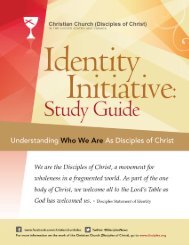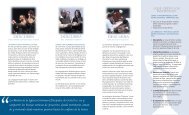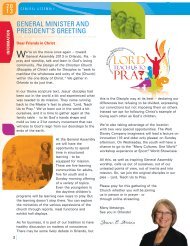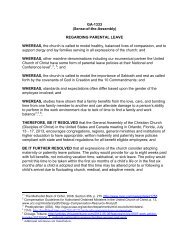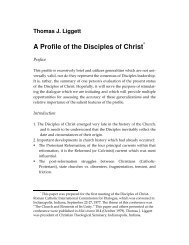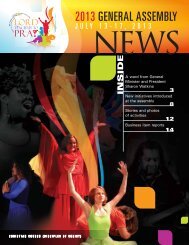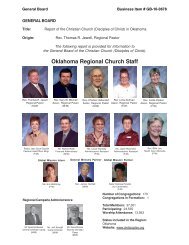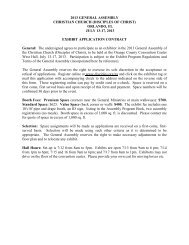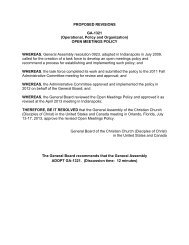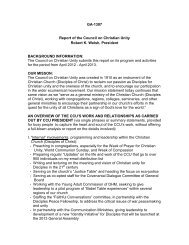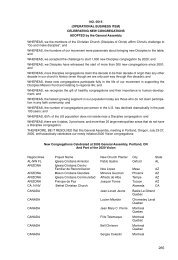Circles of Peace Model - Christian Church (Disciples of Christ)
Circles of Peace Model - Christian Church (Disciples of Christ)
Circles of Peace Model - Christian Church (Disciples of Christ)
You also want an ePaper? Increase the reach of your titles
YUMPU automatically turns print PDFs into web optimized ePapers that Google loves.
The circle takes the community away from the hierarchical form <strong>of</strong> community that wehave become used to and takes us forward into a model where each voice is heard – andthose being silent are noted.How <strong>Circles</strong> FunctionEach circle is “called” by an individual or a group <strong>of</strong> people who have defined anintention for the circle. This could be a circle <strong>of</strong> inquiry on issues <strong>of</strong> globalization that ismeeting so the individuals in the circle can achieve more clarity on how to liveintentionally in the world. It might be a circle <strong>of</strong> discernment to determine how best towelcome and empower the marginalized that comes through our door. Or a circle mightbe formed out <strong>of</strong> a need by a group for a safe place to strengthen each other as they havebeen buffeted by the world because <strong>of</strong> a difference between them and the majority.Whatever the intention – it is clearly stated so there is common understanding by theparticipants in the group.The Participants Invitations to the group may be done by prayerfully considering thefolks in the directory, posted on the bulletin board or advertised in the Crusader andneighborhood newspapers. Those invited might include only the cabinet or executivecommittee. How the invitations are done would depend on the intention <strong>of</strong> the circle.The Explanation At the first meeting <strong>of</strong> the circle the caller gathers the group togetherwith introductions, naming <strong>of</strong> the intention <strong>of</strong> the circle and an explanation <strong>of</strong> how circleswork. If the form <strong>of</strong> meeting takes hold, this will take less time as folks become morefamiliar with the model.The Center Something is placed in the center <strong>of</strong> the circle to acknowledge the center asthe hub, the holding space <strong>of</strong> the energies flowing through it, the place where Spiritresides. This can be as simple as a <strong>Christ</strong> candle or symbols <strong>of</strong> the intention <strong>of</strong> the circleor perhaps each individual is invited to place something in the center to anchor them.Meditation Following the initial welcome, someone will lead an exercise to helpeveryone leave the social arena <strong>of</strong> the everyday world and join the contemplative spacearound the circle.Greeting/Check-In The greeting/check-in is an opportunity for everyone around thecircle to learn more about each other. This is not simply the “getting acquainted”exercises <strong>of</strong> many groups, but a time to help each one in the circle understand otherparticipants more fully. This is helpful when opinions are shared. In a new group thismay be a brief introduction. In ongoing groups it might be a time for folks to shareanecdotal information, <strong>of</strong>fer a social comment or simply to say again why they are in thegroup – reaffirming their commitment.Discussion/Agenda Because there is no one leader in the group but a group <strong>of</strong> leaders,the discussion/agenda is agreed upon by the group. This is generally set up at eachmeeting for the next session. It is essential to the functioning <strong>of</strong> the circle that leadershiprotates – this does not mean that every one lead discussion, but it is important that<strong>Circles</strong> <strong>of</strong> <strong>Peace</strong> Page 6 <strong>of</strong> 9 Revised June 2013
everyone has the opportunity to contribute and that the same individual doesn’t lead alldiscussion. Ideally, different people would begin different parts <strong>of</strong> the discussion. Forexample on the topic <strong>of</strong> globalization, someone might have an interest in the globalworkforce while another person may focus on trade agreements.Checkout/Farewell Prior to ending the session, each person around the circle is giventhe opportunity to comment on the discussion, how they are feeling, what they would liketo see happen next. The next session <strong>of</strong> the circle is planned and a ritual is followed toreturn the group back to social arena from which they came. This can be as simple assnuffing out the <strong>Christ</strong> candle as is done in Children’s Worship & Wonder with the words“The light <strong>of</strong> <strong>Christ</strong> that was in one place at one time was changed to be in all places atall times.” Or perhaps simply “Go in peace.”CovenantsIn order for the circle to work, there are covenants to which the participants agree at thefirst meeting. The wording for these covenants was developed by <strong>Christ</strong>ina Baldwin andcan be found on the Peer Spirit website:http://www.peerspirit.com/htmlpages/circlebasics.html• We will hold stories or personal material in confidentiality and honor othermaterial, information or decisions with a level <strong>of</strong> confidentiality appropriateto the setting.• We listen to each other with compassion and curiosity.• We ask for what we need and <strong>of</strong>fer what we can.• We agree to employ a group guardian to watch our need, timing, andenergy. We agree to pause at a signal, and to call for that signal when wefeel the need to pause. (This signal may be a chime, bell or rattle, at whichsound all action stops, people recenter, the guardian signals again andspeaks to the need he/she felt in the group.)A note about confidentiality: It is important within the community <strong>of</strong> the circle thatparticipants feel safe to share their stories without fear that things will be shared outsidethe circle without their permission. It is also important to the larger community that thelearnings <strong>of</strong> the circle be shared. When sharing the new wisdom gleaned from the circle,it is best to use I statements rather than share personal information belonging to someoneelse. Other issues with repeating anecdotes and others opinions is that in the retelling, thestory is out <strong>of</strong> context. For example, if I say that Alex believes non-documented workersare criminals, it means something completely different if that is followed up with “and Ithink we should work to do something to change that status.” Context is important.Confidentiality is important.<strong>Circles</strong> <strong>of</strong> <strong>Peace</strong> Page 7 <strong>of</strong> 9 Revised June 2013
Developing the QuestionsDepending on the reason for calling the circle, it is probable that having some questionsto guide the nature <strong>of</strong> the conversation would be helpful. It is important to prepare thequestions as well as possible to not bias the direction <strong>of</strong> the conversation. Below are acouple <strong>of</strong> examples <strong>of</strong> question sets that have been used as well as the set that will beused for our conversation on immigration at General Assembly.One congregation beginning a new phase <strong>of</strong> capital improvements asked the followingquestions during a Circle <strong>of</strong> Inquiry called by the pastor and moderator:1. What do you celebrate about our building? What are the joys? What is beneficialfor our mission?2. What concerns do you have? What is not beneficial for our mission?3. What is God calling us to do regarding the building?A group in the same congregation that worked with IndyCAN, a grassroots communityorganizing organizations was exploring the issue <strong>of</strong> health care and the sense <strong>of</strong> thecongregation on that issue. The questions they used for a called circle included:1. What concerns, issues and stories do you have about health care and the healthcare system from a personal and family perspective?2. What concerns, issues and stories do you have about health care and the healthcare system as a member/participant <strong>of</strong> CCC and as a resident <strong>of</strong> our city, stateand country?3. As a community <strong>of</strong> faith what are the justice, equity and ethics questions weshould be wrestling with regarding health care and the health care system?We will use comparable questions for our immigration discussion.1. What concerns, issues and stories do you have about immigration from a personaland family perspective?2. What concerns, issues and stories do you have immigration as amember/participant <strong>of</strong> you local congregation and as a resident <strong>of</strong> your city, stateand country?3. As a community <strong>of</strong> faith what are the justice, equity and ethics questions weshould be wrestling with regarding immigration and immigration laws?This process was developed and has been used at Central <strong><strong>Christ</strong>ian</strong> <strong>Church</strong>, Indianapolis.For more information contact Glenda Survance at gsurvance@mac.com or 317.413.1139.Baldwin, <strong>Christ</strong>ina, Calling the Circle: The First and Future Culture, 1998:Bantam BooksBaldwin, <strong>Christ</strong>ina, Anne Linnea, and Margaret Wheatley, The Circle Way: A Leader inEvery Chair, 2010: Barret-Koehler Publishers<strong>Circles</strong> <strong>of</strong> <strong>Peace</strong> Page 8 <strong>of</strong> 9 Revised June 2013
Short explanation:We meet in <strong>Circles</strong> <strong>of</strong> Inquiry because we believe that the greatest wisdom lies in thecenter <strong>of</strong> the circle around which we gather with a myriad <strong>of</strong> stories, histories andperspectives. We gather with respect to those who have gathered around the circle withus and in respect <strong>of</strong> the topic to be discussed. Perhaps most importantly we invite God tothe center <strong>of</strong> our circle – to lead us thru discernment to understanding. We understandthat sincerely asked questions lead us on a path to new understanding and can teach thosewho are the recipients <strong>of</strong> the question as much as the answer will teach the one whoasked. We also understand the circle is not about coming to the end <strong>of</strong> discussion with asingle voice, but rather to give each soul information to consciously make their owndecision and to leave the circle and move forward with new understanding.<strong>Circles</strong> <strong>of</strong> <strong>Peace</strong> Page 9 <strong>of</strong> 9 Revised June 2013



